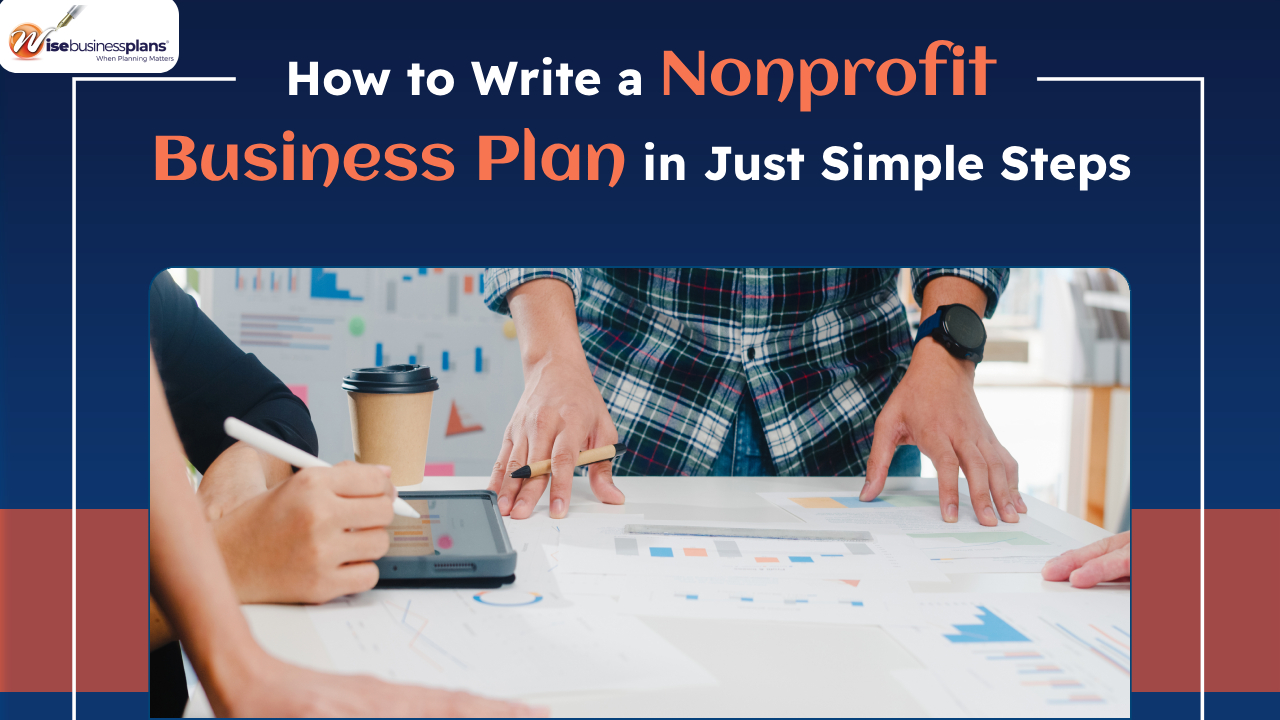How to Write a Nonprofit Business Plan in just 7 simple steps
Table of Contents
- Follow These Simple Steps To Write Your Non Profit Business Plan
- Step 1: Mind your audience
- Step 2: Outline your plan
- Step 3: Keep formatting simple
- Looking for business plan writers?
- Step 4: Divide sections clearly
- Step 5: Display your data aesthetically
- Step 6: Hire an editor
- Step 7: Keep the tone positive!
- FAQ'S of Non-Profit Business Plan
A nonprofit business plan is a document that describes your nonprofit’s mission, goals, strategies, and financial projections. It helps you communicate your vision to donors, stakeholders, and staff, as well as guide your decision-making and operations.

Writing a nonprofit business plan can seem daunting, but it doesn’t have to be. Here are some easy-to-follow steps to create a comprehensive and effective plan for your nonprofit. If you want to learn how to start your non-profit business, Read This Guide.
Access Our Free Non Profit Business Plan Sample
Follow These Simple Steps To Write Your Non Profit Business Plan
Step 1: Mind your audience
Remember that not everyone who reads your plan will be as experienced and knowledgeable as you are. You need to tailor your language and tone to suit your audience’s needs and expectations. For example, if you are writing for potential funders, you need to emphasize your impact, sustainability, and competitive advantage. If you are writing for internal use, you need to focus on your objectives, action plans, and performance indicators. Knowing your target audience is crucial for your marketing and sales. Find out how to identify and reach them with these proven tips.
Step 2: Outline your plan
Make a nonprofit business plan outline that covers the main sections of your plan. These include:
- Executive summary: A brief overview of your nonprofit’s mission, vision, goals, strategies, and financial summary. Learn more on business plan executive summary.
- Organization Overview: A description of your nonprofit’s history, legal structure, governance, management, staff, and location. Check our detailed guide on business plan company overview.
- Market analysis: A research of your target market, beneficiaries, competitors, collaborators, and industry trends. Learn more on business plan competitive analysis.
- Programs and services: A detailed explanation of what programs and services you offer, how they address the needs of your beneficiaries, and what outcomes you expect to achieve.
- Marketing and fundraising plan: A strategy for how you will promote your nonprofit’s brand, reach out to potential donors and supporters, and generate revenue from various sources. .Find our guide on what to include in marketing plan in business plan.
- Operational plan: A breakdown of how you will implement your programs and services, including your resources, processes, systems, policies, and procedures. Do you want to explore more, find how operations plan works in business plan.
- Financial plan: A projection of your income statement, balance sheet, cash flow statement, and budget for the next three to five years. Read more on what to include in business plan financial plan.
Looking for inspiration for your nonprofit business plan? Check out these 11 amazing non profit business plan example.
Step 3: Keep formatting simple
Think back to when you were in school. Did you enjoy reading long paragraphs of text with no visual aids? Probably not. The same goes for your readers. You want to make your plan easy to read and understand by using clear headings, bullet points, tables, charts, graphs, and images. You also want to use consistent fonts, colors, and styles throughout your document.
A business plan outline is a roadmap for your success. Learn how to write a clear and compelling one with these simple steps.

Looking for business plan writers?
Create a specialized business plan with our writers!
Step 4: Divide sections clearly
Each section of your plan should have a clear purpose and flow logically from one to another. You should also use transitions and summaries to connect the different sections and highlight the main points. For example:
- Start with an executive summary that summarizes the key information from each section.
- End each section with a conclusion that recaps the main points and links them to the next section.
- Use subheadings to divide each section into smaller topics.
- Use numbered or bulleted lists to present multiple items or steps.
Want to Learn how to write a business plan? Access our step by step guide on how to write a business plan!
Step 5: Display your data aesthetically
Data is an essential part of your plan. It shows that you have done your homework and that you have evidence to support your claims. However, data can also be boring or confusing if not presented well. You want to use data visualization tools such as tables, charts, graphs, and images to display your data in a way that is easy to comprehend and appealing to the eye. You should also use captions, labels, legends, and sources to explain what the data means and where it comes from.
Step 6: Hire an editor
No matter how good you are at writing or how confident you are in your plan, you should always have someone else review it before you finalize it. An editor can help you catch errors in grammar, spelling, punctuation, formatting, logic, consistency, clarity, and accuracy. They can also give you feedback on how to improve your content and structure. You can hire a professional editor or ask a colleague or friend who has experience in writing or reviewing business plans.
Step 7: Keep the tone positive!
Writing a nonprofit business plan can be challenging and stressful. You may encounter difficulties or uncertainties along the way. However, you should not let that affect the tone of your plan. You want to convey a sense of optimism, enthusiasm, passion, and confidence in your nonprofit’s mission and vision. You want to show that you have a clear direction for the future and that you are ready to overcome any obstacles or risks that may arise.
By following these steps, you can create a nonprofit business plan that will impress your readers and help you achieve your goals. Remember that your plan is not set in stone. You should update it regularly as your nonprofit grows and changes.
Do you want to make a positive difference in the world while running a sustainable business? Here are 53 brilliant non-profit business ideas that you can start today.
Access our free business plan templates now!
FAQ'S of Non-Profit Business Plan
Nonprofit and not-for-profit are terms that describe a type of organization that does not distribute its surplus income to owners or shareholders, but rather uses it for a social or charitable cause. Not-for-profit is usually written with hyphens, while nonprofit is usually written without hyphens.
Planning in a not for profit is creating a strategic plan that guides the organization.
The strategic plan involves:
Reflecting on the mission
Identifying the most important goals
Determining the strategies to reach them
Measuring the progress and outcomes
Planning in a not for profit also requires:
Engaging the staff, board, and other stakeholders
Revisiting the plan regularly as the environment changes
A non-profit example is an organization that does not distribute its surplus income to owners or shareholders but rather uses it for a social or charitable cause. Some common examples of non profits are:
Charitable organizations, such as hospitals, universities, national charities, and foundations.
Religious organizations, such as churches, mosques, temples, and synagogues.
Volunteer service organizations, such as labor unions, legal aid societies, and animal welfare groups.
Research organizations, such as institutes, think tanks, and academic centers.
Cultural organizations, such as museums, libraries, and arts groups.
A non-profit (NPO) is an organization that does not aim to make a profit, but to serve a social or public benefit.
To write a non-profit project proposal, you need to follow these steps:
Identify the problem or need that your project will address
Research the existing solutions and gaps in the field
Define your goals, objectives, activities, outcomes, and indicators
Develop a budget and a timeline for your project
Write a clear and concise summary of your proposal
Include supporting documents such as letters of support, resumes, etc.
A summary of a non-profit organization is a brief overview of its mission, vision, values, programs, impact, and achievements. It should highlight what makes the organization unique and why it deserves support.
The 7 steps of a business plan are:
Executive summary
Company description
Market analysis
Product or service description
Marketing and sales strategy
Financial plan
Appendix
– There is no definitive answer to what is the best type of nonprofit, as different nonprofits may have different goals, missions, and strategies.
– However, some possible criteria to evaluate nonprofits are: impact, efficiency, transparency, accountability, and sustainability.
– Impact refers to how well the nonprofit achieves its intended outcomes and creates positive change for its beneficiaries and society.
– Efficiency refers to how well the nonprofit uses its resources, such as time, money, and staff, to deliver its services and programs.
– Transparency refers to how openly the nonprofit communicates its activities, finances, and results to its stakeholders and the public.
– Accountability refers to how the nonprofit adheres to ethical standards, legal regulations, and best practices in its operations and governance.
– Sustainability refers to how the nonprofit ensures its long-term viability and resilience in the face of challenges and changes.
– Public charities: These are organizations that receive most of their funding from the general public or the government, and they usually have a broad charitable purpose.
– Private foundations: These are organizations that are funded by a single source, such as a family, a corporation, or an individual, and they usually make grants to other charities rather than operate their own programs.
– Hybrid organizations: These are organizations that combine elements of both public charities and private foundations, such as donor-advised funds, supporting organizations, and community foundations.

